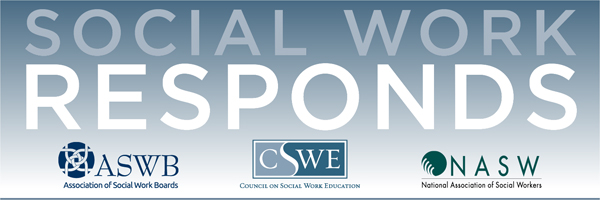Published on : April 30, 2021

The Association of Social Work Boards (ASWB), the Council on Social Work Education (CSWE), and the National Association of Social Workers (NASW) are committed to collaborating on the range of issues affecting the social work profession and the people and communities we serve.
Follow-Up
CSWE’s Commission on Educational Policy and Commission on Accreditation released the first draft of the 2022 Educational Policy and Accreditation Standards(Opens in a new window) (EPAS); we ask that interested participants complete this feedback survey(Opens in a new window) of the 2022 EPAS first draft by May 18, 2021. The feedback from this survey will be incorporated into the second draft of EPAS, which will be released in fall 2021.
Suppressing Voter Suppression
Social workers can be proud of their voter mobilization efforts in the 2020 elections. With more than 158.4 million ballots cast, nearly two-thirds of eligible voters exercised their right to vote. These elections are on record as having one of the highest voter turnouts, despite the disruption of the COVID-19 pandemic, allegations of voter fraud, and delays in postal service that affected timely delivery of some mail-in ballots. Voter turnout increased in every state during the 2020 elections (DeSilver, 2021).
As with any successful organizing effort, however, there is sometimes backlash—the familiar dance of “one step forward, two steps back.” Such is the case with recent voter suppression efforts. By the beginning of April, four states had enacted five voter suppression measures. Additionally, 47 states are considering 361 bills with restrictive voting provisions. Between February 1 and March 25, the number of such bills had increased 43% according to a Brennan Center report (2021, April 1). These targeted disenfranchisement activities disproportionately affect marginalized and underrepresented groups, primarily voters of color.
The For the People Act of 2021(Opens in a new window), which NASW supports and which passed the U.S. House on March 3 and is now pending in the Senate, would counter state-based efforts to restrict voting. The legislation calls for several reforms, including establishing national standards to ensure that all eligible citizens can vote, guaranteeing voter access through mail and early voting, and extending automatic voter registration nationwide. According to a January 2021 poll by Data for Progress, nearly 67% of American voters broadly support this legislation. The John R. Lewis Voting Rights Act seeks to restore the Voting Rights Act, which was eroded by a 2013 Supreme Court decision, and strengthen the provisions to protect the freedom to vote by all Americans, especially voters of color. And through an executive order, President Biden has enlisted the help of all federal agencies to boost voter registration and participation.
Ways to Be Involved
Voting rights and increasing voter participation(Opens in a new window) continue to be among NASW's top social justice priorities(Opens in a new window).
CSWE and many education-focused organizations continue to call for strategies and legislation that not only support the right to vote but improve access to voting for all communities. Through voter registration efforts on campuses and surrounding communities(Opens in a new window), educators and students play a key role in making sure that each person's voice is heard through the ballot box. CSWE's Policy Practice in Field Education Initiative(Opens in a new window) has enabled schools of social work to create integrative models that heighten the policy skill set of undergraduate- and graduate-level social work students, regardless of specialization.
Elections Advance the Profession
Membership in NASW, CSWE, and ASWB also affords the right to vote in matters pertaining to each organization. This includes elections for the board of directors, opportunities to vote on revisions to organizational bylaws, and updates to NASW’s Social Work Speaks(Opens in a new window) policy statements.
In the case of ASWB, members vote on amendments to the Model Social Work Practice Act(Opens in a new window), for example. Unlike NASW and CSWE, which have individual members, ASWB has 64 organizational members: the social work regulatory boards of the United States and Canada. Each regulatory board has the right to be represented by one voting delegate at the association’s annual meeting, where elections take place.
At NASW, thousands of members empower nearly 300 chapter and board representatives in the Delegate Assembly(Opens in a new window) to establish program priority goals for the entire association and to make changes to the Code of Ethics as needed. NASW’s election for its national board of directors(Opens in a new window) is cin progress through May 28.
CSWE is governed by a Board of Directors that is elected by members, and those elections are currently under way. The board is composed of members from across the country and represents educational programs, faculty, practitioners, ethnic minority groups, and private citizens. The work of CSWE is propelled by its councils and commissions, which are made up of volunteer members appointed to 3-year terms by the CSWE Board Chair each July. Learn more about CSWE's various councils and commissions and where your talents can be best applied(Opens in a new window) to advance social work education.
More Work to Do
The 15th Amendment (1870) attempted to eliminate racial barriers to voting, the 19th Amendment (1920) gave women the vote, and the Civil Rights Act (1964) and the Voting Rights Act (1965) changed the landscape of voting rights for generations. Each milestone took many years and millions of advocates to enact. In the wake of the 2020 elections—what many would call a victory for democracy—the country is entering a new time of crisis with respect to the vote. Social workers, who have long championed voting rights and voter engagement, have an opportunity to lead in these important efforts yet again.
References
DeSilver, D. (2021, January 28). Turnout soared in 2020 as nearly two-thirds of eligible U.S. voters cast ballots for president. Fact-tank. https://www.pewresearch.org/fact-tank/2021/01/28/turnout-soared-in-2020-as-nearly-two-thirds-of-eligible-u-s-voters-cast-ballots-for-president/(Opens in a new window)
Brennan Center for Justice (2021, April 1). Voting Laws Roundup: March 2021. https://www.brennancenter.org/our-work/research-reports/voting-laws-roundup-march-2021(Opens in a new window)
Data for Progress. (2021, January 22). 67 percent of Americans support H.R.1 For the People Act. https://www.dataforprogress.org/blog/2021/1/22/majority-support-hr1-democracy-reforms(Opens in a new window)
Social Work Resources
NASW's 2021 Blueprint for Federal Social Policy Priorities(Opens in a new window) is organized according to the Grand Challenges for Social Work, a research-informed social policy agenda, developed by the social work profession, to address society’s most pressing social problems. The Blueprint is a roadmap for social progress and reflects social work’s best thinking on the pathway to a more just and equitable society.
CSWE has a list of resources to help educators, including the new Teaching With and Teaching About Technology initiative(Opens in a new window). The materials include advanced practice knowledge and practice behaviors related to the EPAS, syllabi, bibliographies, case studies, assessment tools, and videos for use in the classroom. Access these resources today!(Opens in a new window)
Social Work Responds Going Quarterly
Our three organizations launched this newsletter at the outset of the pandemic to help you adapt to practicing and working with all the changes that COVID-19 brought about. Social Work Responds has helped us highlight key resources and offer thoughts and guidance for over a year, and we hope that you have found these issues helpful and useful. The newsletters themselves evolved from dealing strictly with the COVID-19 pandemic to allow us to address the racism pandemic that has plagued our country and our practice. Social Work Responds has also brought our organizations closer together and we will continue to build these relationships going forward.
Social Work Responds will be published quarterly for the rest of 2021. Although the need for social workers to respond to today's emerging and ongoing crises at the micro, mezzo, and macro levels has not changed, this schedule will allow us to carefully plan out each newsletter and set of resources that can help you practice safely and to the best of your ability.

